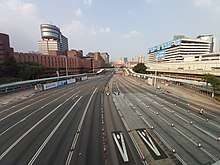Cross-Harbour Tunnel
The Cross-Harbour Tunnel (abbreviated CHT or XHT) is the first tunnel in Hong Kong built underwater. It consists of two steel road tunnels each with two lanes constructed using the single shell immersed tube method.[1]
| Overview | |
|---|---|
| Location | Beneath Victoria Harbour, between Hung Hom and Causeway Bay |
| Coordinates | 22°17′29″N 114°10′56″E |
| Status | Active |
| System | Part of Route 1 |
| Start | Hung Hom, Kowloon (between Hong Chong Road and Salisbury Road) |
| End | Northern Causeway Bay, Hong Kong Island (Canal Road Flyover) |
| Operation | |
| Opened | 2 August 1972 |
| Owner | Hong Kong Government |
| Operator | Serco Group (HK) Ltd |
| Traffic | Vehicular |
| Vehicles per day | 116,754 |
| Technical | |
| Length | 1.86 kilometres (1.16 mi) |
| No. of lanes | 4 lanes (2 lanes per direction) |
| Operating speed | 70 kilometres per hour (43 mph) (within tunnel) 50 kilometres per hour (31 mph) (exit and entrance to tunnel) |
| Cross-Harbour Tunnel | |||||||||||||
|---|---|---|---|---|---|---|---|---|---|---|---|---|---|
 | |||||||||||||
| Chinese | 海底隧道 | ||||||||||||
| Jyutping | Hoi2dai2 Seoi6dou6 | ||||||||||||
| Literal meaning | Seabed tunnel | ||||||||||||
| |||||||||||||
| Alternative Chinese name | |||||||||||||
| Traditional Chinese | 紅磡海底隧道 | ||||||||||||
| Simplified Chinese | 红磡海底隧道 | ||||||||||||
| Jyutping | Hung4ham3 Hoi2dai2 Seoi6dou6 | ||||||||||||
| Literal meaning | Hung Hom seabed tunnel | ||||||||||||
| |||||||||||||
It is the earliest of three vehicular harbour crossings in Hong Kong, opened for traffic on 2 August 1972. It was constructed under a 30-year private-sector franchise based on a build–operate–transfer model, and the title passed to the Hong Kong government in August 1999 upon termination of the franchise. It has become one of the most congested roads (mainly towards the Hong Kong Island direction) in Hong Kong and the world, with 116,753 vehicles passing through it daily in 2013.[2]
History

The Hong Kong government used the operator model "Build Operate Transfer", or "BOT", for the implementation of the tunnel project; Financing and construction was the responsibility of a private enterprise, which was granted a concession to operate and collect tolls for 30 years. The concession was given to the then Cross-Harbour Tunnel Company Limited (Chinese: 香港隧道有限公司), today the Cross-Harbour Holdings Limited (港通控股有限公司), which was founded in 1965 to carry out the tunnel project. The Hong Kong government participated to 20% in order not to fully hand over their influence on the project. The tunnel was designed with two lanes for each direction of travel for a capacity of 80,000 vehicles. The project was structurally managed jointly by the British engineering firms Scott Wilson Kirkpatrick & Partners and Freeman Fox & Partners. The tunnel links the main financial and commercial districts on both sides of Victoria Harbour, connecting Kellett Island (a former island now connected to Hong Kong Island by reclamation), with a reclaimed site at Hung Hom Bay, Kowloon. The toll plaza is located at the Hung Hom end of the tunnel, and has 14 toll booths. It provides the first road link between Kowloon and Hong Kong Island. Prior to the opening of the tunnel, cross-harbour vehicular traffic depended on ferries and for passengers, the Star Ferry. The project was joint-engineered by Scott Wilson Kirkpatrick & Partners and Freeman Fox & Partners [3]
Construction began in September 1969 and was to last four years. The concession period ran from the start of construction, and the operator accordingly completed the construction one year faster than planned. On 2 August 1972, the tunnel was opened for traffic, charging HK$5 per car crossing. After just three and a half years of operation, the operator had recouped the construction costs.
In 1984, the Hong Kong government introduced a tax in addition to the operator's toll to make the overcrowded tunnel less priced. The price for a car transit was now HK$10.
In 1993, an electronic toll collection system was installed. Together with measures to control the flow of traffic, the vehicle capacity could be increased.
It was administered by The Cross-Harbour Tunnel Company Ltd until August 1999, when the operation franchise agreement expired and the government assumed control. Since 1 November 2010, the tunnel has been managed, operated and maintained by Serco on a contract basis.[4]
The 2017 Hong Kong action film Shock Wave, starring Andy Lau, set its main plot in the tunnel.
In November 2019, Hong Kong protesters set roadblocks across the northern tunnel entrance and set fire to tollbooths, as many roads around PolyU were blocked, leading to the closure of the tunnel for a dozen of days.[5]
Transport
As of 2018, there are 44 bus routes passing through the tunnel.
See also
- Harbour crossings in Hong Kong
- List of tunnels and bridges in Hong Kong
- Megaproject
References
- The Hong Kong Cross-Harbour tunnel (Figure 11-3 and Figure 11-12). Technical Manual for Design and Construction of Road Tunnels – Civil Elements Chapter 11 – Immersed Tunnels. United States Department of Transportation – Federal Highway Administration. Updated: 4 May 2011. Accessed 2013-01-18.
- "Drivers facing three more years of jams in Cross-Harbour Tunnel". South China Morning Post. 19 February 2014. Retrieved 28 August 2014.
- http://scottwilsonscotlandhistory.co.uk/Appendix%201%20Mainly%20Projects/SW%20History%20Doc%2013%20Appx%201%20HK%20Cross-Harbour%20Tunnel%20Opening%201972.pdf
- "Transport–Cross-Harbour Tunnel"
- As it happened: Hong Kong protesters set Cross-Harbour Tunnel tollbooth alight again as tear gas fired in Kwai Chung and Yuen Long South China Morning Post, 13 November 2019, Retrieved 15 November 2019.
- "Consultancy Study on Rationalising the Utilisation of Road Harbour Crossings". Wilbur Smith Associates Limited, November 2010
External links
| Wikimedia Commons has media related to Cross-Harbour Tunnel. |
- Cross-Harbour Tunnel By-laws (chapter 2301, Laws of Hong Kong) [1984 Ed.], c/o University of Hong Kong.
| Preceded by Canal Road Flyover |
Hong Kong Route 1 Cross-Harbour Tunnel |
Succeeded by Hong Chong Road |